THE Gold Coast’s rich and famous have called the city’s famous canal estates home for six decades.
Rock stars, movie gods, mayors and developers have all lapped up its prized and expensive plots of land.
Some of the city’s most expensive property has fronted the canals which flow from the Nerang River, making the Isle of Capri and Chevron Island some of the most in-demand suburbs through the late 20th century.
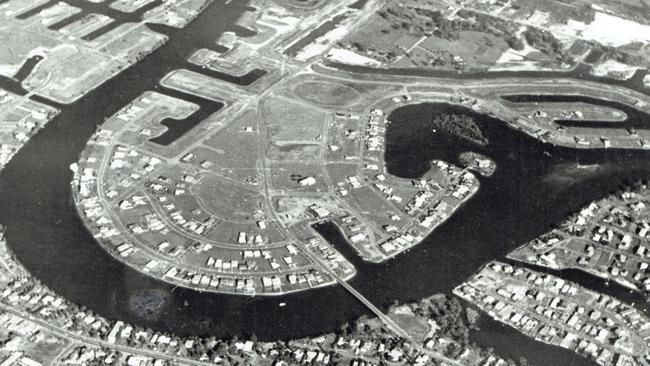
Gold Coast property: $787 million in real estate sales in the first three months of 2021
Man-made canals, inlets and property developers in hot property suburbs such as Sovereign Islands, Ephraim Island, Palm Beach and Elanora have reshaped the locations and helped make the city known.
But the Gold Coast has also paid the price for its canals, with significant rain events bringing about massive damage to surrounding properties in both 1974 and again in 2005.
In part one of our look at the city’s canals, we reveal their origin and the key figures who made the dream a reality.
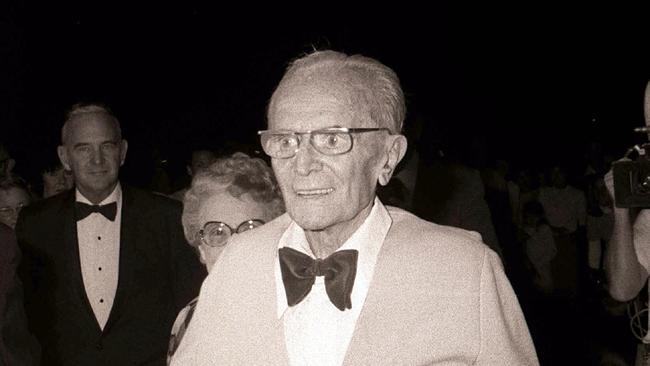
The creation of the canal estates largely is attributed to three towering figures – Sir Bruce Small, Jock McIlwain and Stanley Korman. They were behind the creations of Isle of Capri, Chevron Island and Sorrento.
But there is another man who played a key role in making it happen – early real estate agent Laurie Wall who had played cricket with Sir Don Bradman and went on to become known as Surfers Paradise’s original “Mr Millions”.
Gold Coast real estate: Property auctions reach near 100 per cent clearance rate as boom continues
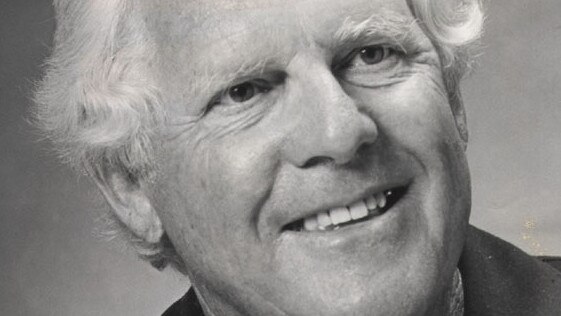
Gold Coast development: New luxury tower planned for Kirra Musgrave St site
No other real estate agent in the Gold Coast’s history played such a significant role in the buying, selling and reshaping of the entire city than the unassuming Sydney-born man who, while obscure today, was regarded in the 1980s as “the King Midas who touched swamps and subdivisions, and turned them into the Gold Coast” and “the uncrowned king of the Gold Coast”.
During his long career he mentored future developer Norm Rix and real estate kingpin Max Christmas, a young carpenter who he taught the ins and outs of the property game.
Gold Coast development: Surfers Paradise ‘bomb sites’ finally set to be built with new towers
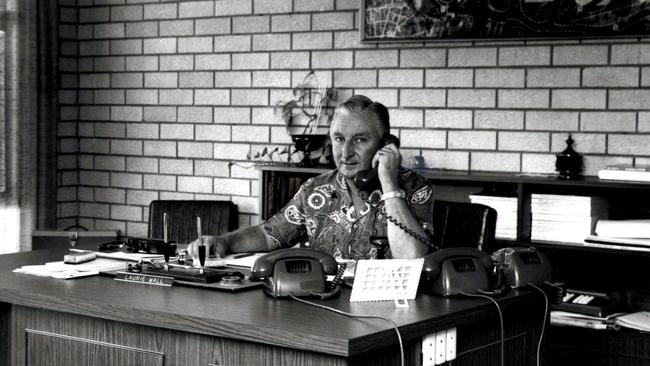
Gold Coast development: Billions of dollars of towers failed leaving Surfers Paradise bombsites
Mr Wall was just 22 years old when he arrived in Brisbane in 1935 while on a stopover during a two-week cruise to New Guinea.
During the trip he had heard of Surfers Paradise and decided to visit.
Recalling the incident in 1988, he remembered walking up to a taxi and asking to be taken south.
The driver declined to drive him the 50-mile trip and instead offered to get him a flight from Archerfield in a four-seat Cessna.
The taxi driver ended up accompanying him on the trip.
“He said he’d take me up for 30 bob,’’ Mr Wall said at the time. “If he’d been a female, I would have kissed him.’’
“So I got a look at it (Surfers Paradise) from the air. When I saw it I thought … ‘phew!’’’
“What beautiful beaches! And the river, and the Broadwater.
“It impressed me colossally. I thought, ‘I reckon I’ll come back sometime, and do something here for sure’.’’
Mr Wall didn’t return to the Gold Coast until 1949 and began rapidly buying and selling property to the generation of developers.
His firm’s slogan was “Wall sells all”.

In 1957 he met Stanley Korman and sold him Wedgewood Island, a sliver of land to the west of Surfers Paradise and built what is today known as Paradise Island.
Impressed at the sales success, Mr Korman snapped up more land and built the city’s first international hotel, The Chevron.
He also set his eyes on Goat Island, a small piece of land in the middle of the Nerang River which Mr Wall sold to him and created Chevron and Cronin islands.
More than 400 people attended the development’s opening in March 1960.
The same year Mr Wall sold Melbourne-born developer Bruce Small land around the Nerang River.
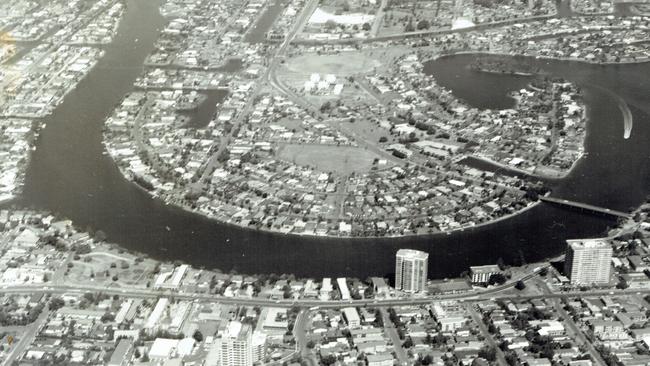
A future Gold Coast mayor and knight of the British Empire, Sir Bruce had been impressed by the canals in the US city of Miami and was keen to replicate it in Australia.
He sold off his Macintosh Island property to Mr Wall for $70,000 to help fund the construction of his canal estates around the Island of Capri.
Sir Bruce had intended to raise the 60ha (150-acre) island 1.6m by dredging the Nerang River.
Mr Wall in turn sold the Macintosh Island site to developer Alex Armstrong who later sold it again to development company Hooker Rex, which subdivided the site and created Paradise Waters.
Mr Wall retired in the late 1970s and moved to Boonah.
But the revolution he began in the 1950s and 1960s with Sir Bruce Small, Stanley Korman and Jock McIlwain began to bear significant fruit.
The creation of the Gold Coast’s famous canal estates between the 1950s and 1990s changed the face of the city and played a key role in its property booms.
These man-made marvels began in the 1950s and gained prominence in the following decade with the Isle of Capri and Sorrento.
Primarily designed by hydro-engineer and developer Jock McIlwain, they were inspired by those of Miami, Florida.

The desire for waterfront living was so strong that it turned these areas, as well as Chevron Island, into the city’s most expensive property for two decades.
Their success also led to hundreds of new man-made waterfront housing developments.
This decades-long frenzy resulted in the Gold Coast today having more canals than Venice.
The 200ha of land now known as Florida Gardens was bought by Savoy Hotels in 1956, but the company was unable to build there because the state government took until 1958 to pass the Queensland Canals Act.

WHEN GOLD COAST'S NEWEST SHOPPING CENTRE WILL OPEN
Frustrated, Savoy sold out in 1960 to Lois and Barry Cleland who dredged and developed the low-lying area progressively through the decade.
Picking up the baton from Isle of Capri developer and mayor Sir Bruce Small, Mr McIlwain proceeded to dramatically expand the canal network with a range of developments in the city’s central suburbs, including Coral Gables, Evandale Waters and the Waterways Wonderland estates.
These areas, built through the 1970s and 1980s, are the canals which form what is today Mermaid Waters and Broadbeach Waters.
Mr McIlwain himself ultimately settled on one of his own parcels at Mermaid Waters where he lived until his death in 2016.
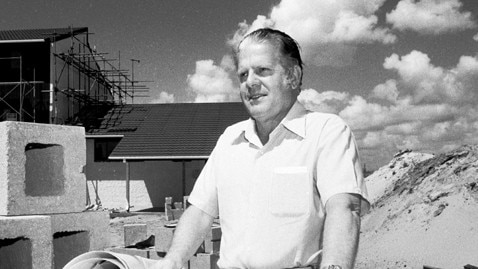
The city’s north also saw dramatic changes between the 1950s and 1980s as land was subdivided and canals built.
In 1967, developer Neil McCowan snapped up more than 182ha of land on the Broadwater then-known as Angler’s Paradise.
MASSIVE CHANGE COMING FOR COAST PROPERTY MARKET
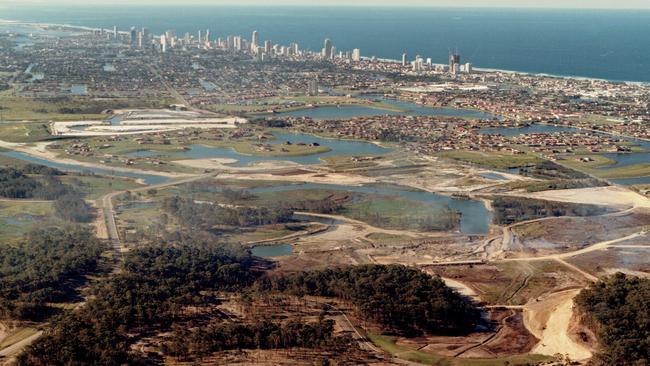
$440M HOTEL SCRAPPED FOR LUXURY BEACHFRONT TWIN TOWERS
In 1972, through his company Lae Enterprises, Mr McCowan subdivided the area and renamed much of it Runaway Bay.
Mr McCowan’s attempt to rename the area was shot down by the state government but, determined to get his way, he simply gave the name to its post office in a bid to popularise it.
The government finally relented in the early 1980s.
Ralph Faulkinder bought up 200ha in Paradise Point and Hollywell in the early 1950s for 600 pounds in back-pay from World War II.
WORK TO BEGIN WITHIN WEEKS ON $150M KFC SITE TOWER
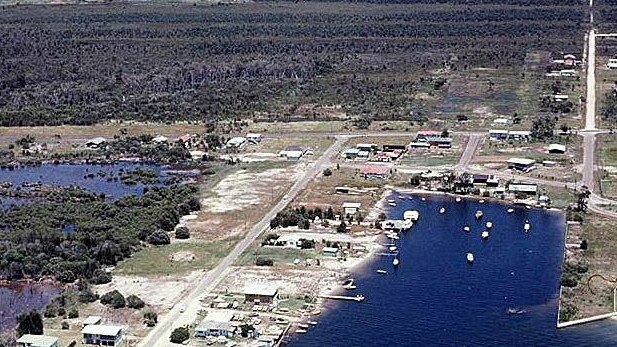
However, the first canal estates were not built there until 1970 when Paradise Point Keys went on the market. Major developer Lewis Land moved in to build the project and, buying up large swathes of land, ultimately developed both Sovereign Islands and Ephraim Island.
By the early 1980s Biggera Waters was also completed.
Joining the frenzy by the early 1980s was billionaire Bob Ell and his company Leda Holdings, which bought up large parcels of swampland at the back of Carrara and built the Clear Island Waters estate.

In 1987 the central Gold Coast suburb of Stephens became the home of a giant man-made lake as part of the Bond University development.
The Bond Corporation – led by colourful businessman Alan Bond – commissioned Neumann Dredging Company, led by fellow former Gold Coast mayor Robert Neumann, to build a giant waterway, which he anticipated would become home to rowing and other major sporting events.
Originally known as Bond University Lake, it was dubbed Lake Orr when the areas surrounding it were bought by developer Delphin in the late 1990s and renamed Varsity Lakes.

But by the early 1990s the canals were falling into disrepair, with their maintenance a source of ongoing tensions between the Gold Coast and Albert Shire councils.
Restoring them was cited as a major logistical reason behind the 1995 amalgamation of the councils.
However, this work was largely left on the backburner for a decade until the Gold Coast was left devastated by a “one in 1000-year” flood in June 2005.
More than 600mm of rain fell on the city and the downpour proved too much for the outdated pipes, which backed up on the night.
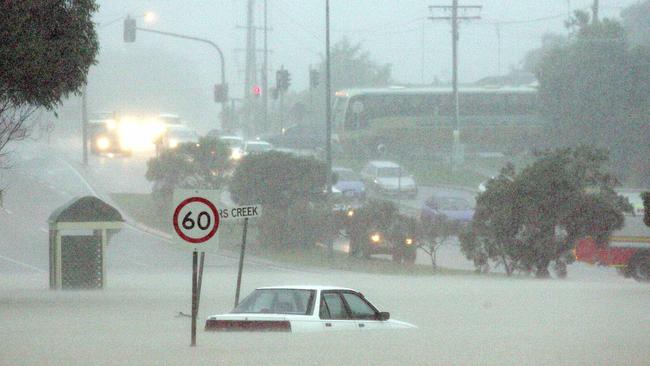
Residents across the Coast woke up on June 30, 2005 to flooding, with more than 70 roads made impassable.
Council’s long-outdated water infrastructure and the sprawling canal estates were blamed for leaving the region vulnerable to such a significant weather event.
A 2005 council report released in the aftermath of the floods revealed much of the city remained at risk, with the low-lying Florida Gardens singled out as a major concern.
Council was forced to spend more than $1 billion over the following decade to flood proof the city.


Add your comment to this story
To join the conversation, please log in. Don't have an account? Register
Join the conversation, you are commenting as Logout
SoundCloud rapper bashes nemesis, found twice with weapons
A Gold Coast musician with aspirations to take his beats global has admitted to a vigilante bashing at Burleigh Heads of a man he incorrectly held responsible for the death of a close friend.
VOTE NOW: The best Thai restaurant on the Gold Coast
We are on the hunt to find the Gold Coast’s best Thai restaurant. Vote for your favourite in the poll here